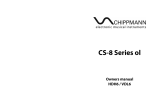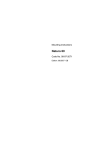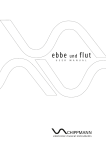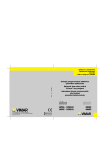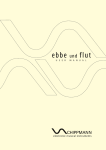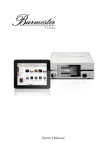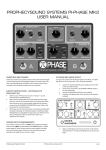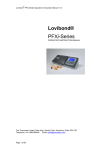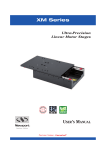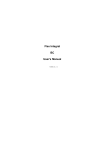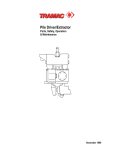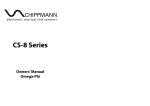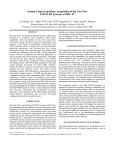Download Owners manual
Transcript
CS-8 Series Owners manual PHS-28 CS-8 Series PHS-28 Rev1.01, Dec. 2013 User manual by Carsten Schippmann Graphic design CS-8 Series: Carsten Schippmann Concept and development: Carsten Schippmann English translation by Carsten Schippmann Contact: Schippmann electronic musical instruments Dipl.-Ing. Carsten Schippmann Wilhelm-Kabus-Str.46 D-10829 Berlin Web: www.schippmann-music.com Email: [email protected] The manufacturer Schippmann electronic musical instruments is constantly striving for improvements and developments of their products. Therefore, we reserve the right to change technical specifications which improve our products at any time without notice. This includes the look of the unit which might differ from pictures in this manual. No part of this publication is to be reproduced, transmitted, transcribed or translated in any form or by any means whatsoever without written permission by Schippmann electronic musical instruments. 2013, Schippmann electronic musical instruments, errors excepted, subject to change without prior notice. -1- CS-8 Series PHS-28 Rev1.01, Dec. 2013 PREFACE First of all, congratulations on the purchase of this 3U euro rack synthesizer module. This manual contains a condensed description of the functionality and addresses users with a certain level of elementary technical knowledge. The PHS-28 is a very versatile and fully analogue voltage controlled 2 channel phaser (phaseshifter) with 8 stages per channel. The channels are cascadable to a true 16 stage phaser with a feedback loop over all 16 stages by one switching click. Very deep and impressive phasing effects are possible with that. The stage for the feedback as well as for the output stage are selectable fully independently. We think that the PHS-28 convinces with an unbelievable, warm forceful sound - it would have bitten almost our head off! The module is designed with a width of 19 PU (part units, 1 PU=5.08mm) for installation into a 3 HU (height units) modular rack with a built in ±12 V power supply. Furthermore the module is equipped with lots of CV (Control Voltage) inputs for phase frequency (FREQ), resonance (RESO) and emphasize (EMPH), separately for each channel that true and independent dual audio operating is possible. Design and implementation meet highest technical standards concerning usability, sound quality, and electromagnetic immunity. The entire design and production work was done in Germany. Made in Germany -2- CS-8 Series PHS-28 Rev1.01, Dec. 2013 1. WARRANTY .........................................................................................................................4 1.1 Limited Warranty ....................................................................................................4 1.2 Terms of Warranty ..................................................................................................4 1.3 Warranty transferability ......................................................................................4 1.4 Claim for damages ..................................................................................................4 2. CE AND FCC COMPLIANCE STATEMENTS ...............................................................5 3. DISPOSAL ............................................................................................................................5 4. SAFETY INSTRUCTIONS .................................................................................................5 5. MAINTAINANCE/ CLEANING ........................................................................................6 6. GETTING STARTET............................................................................................................7 6.1 Unpacking ..................................................................................................................7 6.2 Installation .................................................................................................................7 7. CONTROLS ...........................................................................................................................8 7.1 Front panel .................................................................................................................8 7.2 Back ............................................................................................................................ 10 7.3 Initial operation .................................................................................................... 11 7.4 Calibration .............................................................................................................. 11 8. MODULE DESCRIPTION ............................................................................................... 12 8.1. Layout and functions......................................................................................... 12 9.1 Specifications (generally) ................................................................................. 22 9.2 Ratings ...................................................................................................................... 22 -3- CS-8 Series PHS-28 Rev1.01, Dec. 2013 1. WARRANTY 1.1 Limited Warranty Schippmann electronic musical instruments warrants the mechanical and electronic components of this product for a period of two (2) years from the original date of purchase, according to the warranty regulations described below. If the product exhibits any faults within the specified warranty period that are not excluded from this warranty, Schippmann electronic musical instruments shall, at its discretion, either replace or repair the product. This warranty exists in addition to the general terms of business of the manufacturer Schippmann electronic musical instruments. 1.2 Terms of Warranty Schippmann electronic musical instruments reserves the right to execute warranty services only if the product comes with a copy of the dealer’s original invoice. Final discretion of warranty coverage lies solely with Schippmann electronic musical instruments. Any Schippmann electronic musical instruments product deemed eligible for repair or replacement under the terms of this warranty will be repaired or replaced within 30 days after receiving the product at Schippmann electronic musical instruments. Damages or defects caused by improper handling or opening of the unit by unauthorized personnel (user included) are not covered by this warranty. Products which do not meet the terms of this warranty will be repaired exclusively at the buyer´s expense and returned C.O.D. with an invoice for labour, materials, return shipping, and insurance. Products repaired under warranty will be returned with shipping prepaid by Schippmann electronic musical instruments. Outside Germany, products will be returned at the buyer´s expense. 1.3 Warranty transferability This warranty is extended to the original purchaser and cannot be transferred. No other person (retail dealer, etc) shall be entitled to give any warranty promise on behalf of Schippmann electronic musical instruments. 1.4 Claim for damages -4- CS-8 Series PHS-28 Rev1.01, Dec. 2013 Schippmann electronic musical instruments does not accept claims for damages of any kind, especially consequential loss or damage, direct or indirect of any kind however caused. Liability is limited to the value of this product. The general terms of business drawn up by Schippmann electronic musical instruments apply at all times. 2. CE AND FCC COMPLIANCE STATEMENTS This device has been tested and deemed to comply with the DIN EN 60065 standards. This device has been tested and deemed to comply with the requirements, listed in FCC Regulations, part 15. The device complies with EN 55103-1 and EN 55103-2 standards. Because of the entirely analogue construction, this device does not generate radio frequencies and will not interfere with radio frequencies generated by other electronic devices. 3. DISPOSAL This device has been manufactured to RoHS-standards, in compliance with the requirements of the European parliament and council and is thus free of lead, mercury, and cadmium. !! Notice: This product is still special waste and is not to be disposed of through regular household waste !! For disposal, please contact your local dealer or Schippmann electronic musical instruments 4. SAFETY INSTRUCTIONS BEFORE USING THIS PRODUCT FOR THE FIRST TIME, PLEASE READ THE ENTIRE USER MANUAL THOROUGHLY. -5- CS-8 Series PHS-28 Rev1.01, Dec. 2013 • • • • • • • • • • • • • • PLEASE AVOID SHARP BENDING OF ANY CORDS AND CABLES. CORDS SHOULD NOT BE INSTALLED WITHIN THE REACH OF CHILDREN OR PETS. DO NOT TREAD THE ENCLOSURE OF THE PRODUCT, DO NOT PLACE HEAVY OBJECTS ON IT. BEFORE REMOVING THE PRODUCT FROM THE RACK, PLEASE DISCONNECT THE POWER PLUG AND ALL OTHER CABLE CONNECTIONS. PLEASE DISCONNECT THE POWER PLUG FROM THE OUTLET IN CASE OF A THUNDERSTORM. NEVER OPEN THE ENCLOSURE OF THE PRODUCT! NEVER TRY TO MODIFY THE INTERNAL CIRCUITRY! ONLY QUALIFIED SERVICE PERSONNEL IS ALLOWED TO OPEN THE ENCLOSURE. DO NOT PLACE OPEN FIRE ON TOP OF THE PRODUCT (CANDLES, ASH TRAYS, HOT THAI CURRIES ETC). NEVER EXPOSE THE PRODUCT TO WATER, BEER, OR MOISTURE. ADULTS ARE TO MAKE SURE THAT CHILDREN FOLLOW ALL SAFETY INSTRUCTIONS. SAME THING GOES FOR PETS. AVOID MECHANICAL STRESS OR IMPACT. DO NOT DROP THE PRODUCT; EVEN IF THERE IS A CONTROL LABELLED "DROP"!. DO NOT USE THE PRODUCT WITH TOO MANY OTHER ELECTRONIC DEVICES RUNNING FROM ONE SINGLE OUTLET, ESPECIALLY IN CONNECTION WITH EXTENSION CORDS. DO NOT ATTEMPT TO SAVE MONEY ON CHEAP SOLUTIONS. BUY PROPER HIGH-DUTY POWER DISTRIBUTORS AND CORDS! NEVER USE EXTENSION CORDS WITH LESS MAXIMUM LOAD THAN THE TOTAL POWER CONSUMPTION OF ALL DEVICES CONNECTED TO A SINGLE POWER OUTLET COMBINED. OVERLOADING EXTENSION CORDS CAN CAUSE FIRE. AVOID MECHANICAL STRESS ON SOCKETS AND KNOBS / SWITCHES. PROTECT YOUR SPEAKERS AND EARS (!) AGAINST EXCESSIVE AUDIO LEVELS. THE CS-8 PHS-28 UNIT IS CAPABLE OF GENERATING EXTREMELY LOW AS WELL AS EXTREMELY HIGH FREQUENCIES. BOTH MIGHT CAUSE SERIOUS DAMAGE TO AUDIO EQUIPMENT AND EARDRUMS! 5. MAINTAINANCE/ CLEANING -6- CS-8 Series PHS-28 Rev1.01, Dec. 2013 • • BEFORE CLEANING THE PRODUCT, PLEASE DISCONNECT THE POWER PLUG FROM THE OUTLET OR DISCONNECT THE MODULE FROM ITS POWER CONNECTOR BY PULLING THE FLAT RIBBON CABLE. USE A DRY OR SLIGHTLY MOIST CLOTH OR COMPRESSED AIR FOR CLEANING. NEVER USE ANY CLEANER OR THINNER (E.G. PAINT THINNER OR ACETON). PRINTS AND PAINTWORK WILL IMEDIATELY BE DESTROYED!! ALSO AVOID ALCOHOL (ISOPROPYLIC), GAS, SPIRITS (SCOTCH SINGLE MALTS, FOR A START) OR ABRASIVE HOUSEHOLD CLEANERS! 6. GETTING STARTET 6.1 Unpacking The box should contain the following items: - 1 x CS-8 PHS-28 3HU rack-mount module - 1 x Ribbon cable (20 cm length with two 16 pole IDC-connectors) - 4 x M3 screws - 4 x polypropylene washers - This owners’ manual If the content of the box turns out to be incomplete, please get in touch with your dealer or Schippmann electronic musical instruments immediately. In case of damage caused in transit, please get back to the responsible carrier and Schippmann electronic musical instruments immediately. We will support you in this case. 6.2 Installation Place the unit on a clean, dry and sturdy surface, or use a suitable keyboard stand or 19” rack. For 19” rack mounting, a suitable rack (3U Eurorack with +/12V power supply rails) is required. The CS-8 PHS-28 uses discrete all-analogue electronics. Thus certain parameters, such as Frequency, Resonance and Emphasize, may be temperature-sensitive. We recommend placing the CS-08 PHS-28 away from heat sources such as radiators, lamps or other units that produce heat (e.g. power amps or internal power supplies). -7- CS-8 Series PHS-28 Rev1.01, Dec. 2013 7. CONTROLS 7.1 Front panel Fig. 1 shows the front panel with consecutively numbered controls and jacks. Fig. 1 front -8- CS-8 Series PHS-28 Rev1.01, Dec. 2013 1. 2. 3. 4. 5. 6. 7. 8. 9. 10. 11. 12. 13. 14. 15. 16. 17. 18. 19. 20. 21. 22. Input A control – attenuates the incoming audio signal at Input A jack (channel A) between -∞ dB and 0 dB Input B control – attenuates the incoming audio signal at Input B jack (channel B) between -∞ dB and 0 dB Freq control – adjusts the phase frequency for both channels between1 Hz and 200 kHz Det control – detunes the phase frequency of channel B over ±3.6 octaves (x12 resp. ÷12) Reso control – adjusts the resonance of the phaser (Q-factor) between zero (1) and self-oscillation (∞) for both channels Emph control – adjusts the emphasis of resonance for both channels, commonly Mix A control – mixes the original signal at jack Input A with the phasers effect of channel A proportionally together Mix B control – mixes the original signal at jack Input B with the phasers effect of channel B proportionally together Fb B 2 pos. toggle switch – activates ("on") the feedback loop of channel B FB-Stage 4-pos. rotary switch – selects for both channels the stage for the feedback loops, commonly Fb A / Mode 3 pos. toggle switch – routes the channels A and B in three different ways into parallel or serial modes Out-Stage 4-pos. rotary switch – selects for both channels commonly the effect output stage at the Mix A and Mix B controls and output jacks, resp. Input sel 2 pos. toggle switch – selects for the Mix B-control one of the original inputs A or B Input A jack (input) – audio input channel A Input B jack (input) – audio input channel B +CV A jack (input) – non-inverting CV-input to control the phase frequency of channel A -CV A jack (input) –inverting CV-input to control the phase frequency of channel A +CV B jack (input) – non-inverting CV-input to control the phase frequency of channel B -CV B jack (input) –inverting CV-input to control the phase frequency of channel B Res A jack (input) –CV-input (±5V) to control the resonance of channel A Res B jack (input) –CV-input (±5V) to control the resonance of channel B Emph A jack (input) –CV-input (±5V) to control the emphasis of channel A -9- CS-8 Series PHS-28 Rev1.01, Dec. 2013 23. 24. 25. 26. 27. Emph B jack (input) –CV-input (±5V) to control the emphasis of channel B St-8 A jack (output) –audio output (-2.5 db) of the 8th stage of channel A St-8 B jack (output) –audio output (-2.5 db) of the 8th stage of channel B Mix A jack (output) – audio mix output (ctrl. 7) (-2.5 db) channel A Mix B jack (output) – audio mix output (ctrl. 7) (-2.5 db) channel B 7.2 Back Fig. 2 shows the back of the module with consecutively numbered elements. Fig. 2 back / main PCB of the module -10- CS-8 Series PHS-28 Rev1.01, Dec. 2013 1. 2. 3. 4. pinned phaser module –phaser core channel A pinned phaser module –phaser core channel B Freq A trimmer P5 – calibration of the phase frequency channel A Res A trimmer P7 – calibration of starting point of self-oscillation channel A 5. FTE A trimmer P1 – calibration of the Emph-modulation feedtrough of channel A 6. FTR A trimmer P3 – calibration of the Reso-modulation feedtrough of channel A 7. Freq B trimmer P6 – calibration of the phase frequency channel B 8. Res B trimmer P8 – calibration of starting point of self-oscillation channel B 9. FTE B trimmer P2 – calibration of the Emph-modulation feedtrough of channel B 10. FTR B trimmer P4 – calibration of the Reso-modulation feedtrough of channel B 11. 16 Pin power supply-box header 7.3 Initial operation The power connector’s (8) pin-out in top view (refer to fig. 2) is assigned as follows: Bottom to top, left to right. Thus pin 1 is located at bottom left, pin 2 above pin 1 etc. Pin 15 is at bottom right, pin 16 at top right. Pin 1, 2 = -12 V (labelled with a triangle) Pin 3-8 = GND (regarding ground, 0 V), located outward on all jacks Pin 9, 10 = +12 V Pin 11-16 = not connected To hook up power to the module, connect one of the IDC-connector of the included flat ribbon cable to the box header (refer to fig. 2). Observe guide key for the polarity of the connector in order to avoid pin reversal. The red tag of the cable is to match the triangle-label. 7.4 Calibration All trimmers are 12 gauge trimmers, i. e., 12 turns are needed to cover the entire range. Trimmers P5, P7, P6 and P8 increase their parameters when -11- CS-8 Series PHS-28 Rev1.01, Dec. 2013 turned clockwise. The feedthrough trimmers P1, P3, P2 und P4 are zeroadjustment trimmers and should better be untouched! 8. MODULE DESCRIPTION 8.1. Layout and functions Mix A Amp Mix A Amp St-8 A Amp St-8 B Amp Mix B Line A Input A Out Stage A 1 of 4 Stage 2 Stage 6 Σ Stage 4 1 of 4 Stage 8 Fb Stage A Mode=A/B par, A->B 2x8 Mode=A->B 16 Mode=A->B Fb B = on 1 of 4 Input B Input sel = B Σ Stage 2 Stage 4 Out Stage B Fb Stage B Stage 6 Stage 8 1 of 4 Line B Mix B Fig. 3 signal flow chart -12- CS-8 Series PHS-28 Rev1.01, Dec. 2013 Fig. 3 shows the flow chart of all audio signals of PHS-28. All elements of controls and their regarding jacks were omitted for better clarity. The principles of their operation will be explained as follows. Input: The audio inputs are signed with Input A and Input B, these are pure AC inputs. The controller Input A (1) and Input B (2) are tied capacitively decoupled to their input jacks of the same name. The controller attenuate the incoming audio between 0 and 1. Mix A, Mix B: The outputs Mix A and Mix B are audio outputs, they provide, dependently on the position of the regarding controllers Mix A (7) and Mix B (8), resp. the balance between the original audio input Input A and B, resp. and the regarding effect output of channel A and B, resp.. The output level at these jacks is reduced by -2.5 dB (75%). This avoids internal overloads in certain routings and resonance settings. St-8 A, St-8 B: The outputs St-8 A und St-8 B are audio outputs, they provide the clean effect signal of the regarding channel at their 8th stage. The output level at these jacks is also reduced by -2.5 dB (75%) in the same way as above. Freq: The influencing variables on this parameter will change the phase frequency. That is the frequency where the phase shift is exactly the half of the total possible phase angle (see below). The controller Freq (3) affects both channels and provides a range from 1 Hz to 200 kHz. This is necessary to achieve with 16 stages in the feedback loop with the undermost notch frequency 20 kHz or with the topmost one 20 Hz, respectively (see below). The controller Det (4) (detune) affects only the phase frequency of channel B and achieves a detuning of ±3.6 octaves (x12 resp. ÷12). The regarding control inputs for the phase frequencies are the jacks CV A, -CV A for channel A and CV B, -CV B for the channel B with a sensitivity of ±3 octaves/Volt or a scale of ±330 mV/Oct, respectively. A bit yummy theory: The following two pages shows 16 graphs (Fig. 4). They illustrate the amplitude- and phase responses of a phaser chain at the stages 2, 4, 6, 8, 10, 12, 14 and 16. -13- CS-8 Series PHS-28 Rev1.01, Dec. 2013 -14- CS-8 Series PHS-28 Rev1.01, Dec. 2013 Fig. 4 amplitude-/phase response 2 - 16 Stages -15- CS-8 Series PHS-28 Rev1.01, Dec. 2013 The shown amplitude responses are coming into being when mixing the original signal with the phase shifted one fifty-fifty. The phase response shown here, however, is the pure phaser stage output, because it is more of interest than the mixed result and gives more insight of the system properties. To shift the current phase angle of a real-time signal is only possible when the signal becomes delayed. This will be done with units of energy storages the so called stages. Each stage provides a total phase shift of -180°. Applicationoriented, however, only 360°-units are of interest. Such a unit will be obtained by cascading 2 stages in serial. The input signal, tuned from the lowest to the highest frequencies undergoes a full clockwise rotation (delay, negative phase) of -360°. A superposition of this phase shifted signal with its phase constantly original signal results in a total effacement (notch) of the amplitude response as shown in the graphs. This occurs because at one frequency an angle of -180° or at multiples of it will be achieved, that the amplitude response is interacting in effacements at these frequencies. With each further 360° unit another notch-frequency will come up. So, as many notches will be obtained as 360°-units or twice as much stages are cascaded. Exactly this is shown in the graphs. And one achieved this by dial-in with the regarding rotary switch Out Stage (12) and by mixing of the original input with the effect output at the regarding controllers Mix A (7) and Mix B (8) , resp.. E.g., the topmost two graphs represents the amplitude- and phase response at the second stage (one 360° unit) with exactly one notch at -180° phase shift, here at 1 kHz. And this frequency can be shifted with the parameter Freq. The upcoming notches by cascading further 360° units will be spread exactly symmetrically above and below the center frequency and the distance between the lowest and highest notch increases with every stage pair (360° unit). The undermost graph at the 16th stage shows that the frequency of the lowest notch is 10 times lower than the center frequency, whereas the highest one is 10 times higher. The phase is shifted here at all by minus 2880° or 8·360°. At least since now it becomes clear why such a large range of the parameter Freq. (1 Hz - 200 kHz) is necessary when one wants to shift all notches in the two directions to below and up from the audible audio range. -16- CS-8 Series PHS-28 Rev1.01, Dec. 2013 Reso: The influencing variables on this parameter will change the selfresonance of the phaser chain, by feedback the audio signal at a selected stage to the input (Fig. 3). With that selective gains at certain frequencies will occur, namely exactly at that frequencies where the notches are (Fig. 4), so, at -180°+N·(-360°). The stage for the feedback can be selected with the rotary switch Fb Stage (10) independently of the Out Stage. The provided stages as well as for the out stage are in multiples of 2 (360° units), so, 2, 4, 6, 8 and in A B mode (serial routing of channel A and B, see below) 10, 12, 14 and 16. Figure 5a shows from top to down the amplitude response at the 4th stage (50-50-mix) without resonance, the amplitude response at the 4th stage at high resonance fed back at the 8th stage and at last the corresponding phase response at stage 4. → Previously, it was implied the same center frequency for all 16 stages. But because of the ability to control both channels A and B, separately, even in the serial modes the relationships of the notch frequencies can be further shifted, e.g. by the Det-controller or external CV. By detuning the channels and 2 feedback loops at the same time and working in one of the two serial modes 2.) or 3.) (see below) at certain frequency settings congruence of resonance frequencies (notches) will occur resulting in dramatically higher selectivity at higher resonance values greater than zero. The possibilities are almost endless. -17- CS-8 Series PHS-28 Rev1.01, Dec. 2013 Fig. 5a amplitude- and phase response without and with resonance Figure 5b shows from top to down the amplitude response at the 2. stage (5050 mix) without resonance, the amplitude response at the 2. stage at high resonance at the 12. stage and at last the corresponding phase response at the 2. stage. -18- CS-8 Series PHS-28 Rev1.01, Dec. 2013 Fig. 5b amplitude- and phase response without and with resonance The controller Reso (5) allows a range from no resonance (Reso = 0) up to selfoscillation (Reso > 6). The corresponding CV-inputs are the jacks Reso CV A and Reso CV B. To go fully through this parameter a voltage difference ∆V of 5 Volt is needed. According to the position of the controller Reso a voltage of -5 volts will bring the resonance back to zero, if the position is full clockwise and a voltage +5 volts will bring the resonance up to "10" if the position is full counter clockwise. Emph: This function determines the strength of resonance before selfoscillation occurs. The selective gain (resonance) continues to rise with constantly raise of the resonance until starting to self-oscillate. And the selective gain just before self-oscillation can be set with the controller Emph (6) common for both channels from very thin (Emph = 0.05 - 0.1) to very definite (Emph = 1 - 2). The amplitude of the self-oscillation increases equally. Fig. 6 shall illustrate this fact a little. -19- CS-8 Series PHS-28 Rev1.01, Dec. 2013 level [dB] Emph = 2 Emph = 0.05 fc of } start self-oscillation amplitude phase frequency Fig. 6 amplitude of self-oscillation at different Emph-values The corresponding CV-inputs are the jacks Emph CV A and Emph CV B. To go fully through this parameter a voltage difference ∆V of 5 Volt is needed, in the same way as for the resonance. Mix A/B: The controller Mix A and Mix B represents the weighting of the original input and the corresponding effect output in a linear way depending on the controller's position as hinted above (balance). In full counter clockwise position the original input A or B, resp. is audible and in full clockwise position the clean effect output is audible at the jacks Mix Out A or Mix Out B, resp. with a damping of -2.5 dB as mentioned above. So, in center position a 50-50 mix of both signals will be obtained. Mode: With this mousy but mighty switch both channels A and B can be routed in three different ways. Words will fail sometime, hence one should to melt this relationships in one's mouth by contemplate the Fig. 3. 1.) A/B par (center position): Both channels A and B are working parallel and totally independent in their audio paths. For the Out Stage switch the upper number row is valid and for the Fb Stage switch the bottom row. → 2.) A B 2x8 (down position): Channel A and B are serial routed, which means the 8th stage of channel A is running into the input of channel B. The outputs, especially the Mix Out's maintain their paths. The feedback stages for both channels are commonly selected by the rotary switch Fb Stage, namely stages -20- CS-8 Series PHS-28 Rev1.01, Dec. 2013 2-8 for each channel. So, the both channels, seen as two 8 stage phasers, are simply in a row, however the input B is still kept active. From the perspective of Input A the signal at the output St-8 B and at Mix B 8 runs through the 8 stages of channel A + the selected stage by the Out Stage switch. For the Out Stage switch the upper row of numbers is valid for each channel, singularly, and lower one for the chain A to B. For the Fb Stage switch, consequently, the lower number row is valid for both channels. → 3.) A B 16 (up position): Channel A and B are serial routed in the same way as above. The difference is the feedback loop for channel A. The stages 2-8 of channel B will be feed back to the channel A's input here. Thus, the feedback loop involves the 8 stages of channel A + the selected stage by the Fb Stage switch. The feedback loop of channel B involves furthermore its stages 2-8. For the Fb Stage switch the upper row for channel A is valid and for channel B the lower one. For the Out Stage switch the same as for 2.) is valid. Fb B: This switch activates ("on") or deactivates ("off") the feedback loop of channel B anytime in all modes. Input sel: This switch selects the original signal at Input B ("B") or Input A ("A") for the balance controller Mix B. This is useful in the modes 2.) or 3.), when a generation of a true 10/12/14/16 stage phaser from the perspective of Input A is wished, because the output stages are those of channel B provided at the output Mix B. To mix it with its original input, namely at Input A Mix B has to get Input A now and not B. A remark to the noise topic: Long phaser chains (especially voltage controlled ones) with lots of stages are noisy, namely in the most cases more than filters. Nevertheless, the noise figure isn't the measure of all things. Because there exists really musical and beautiful noise and in opposite to that really ugly and unaesthetic noise. Although, the noise output of the PHS-28 is pretty low, we find its noise character is really terrific and that it will integrate in a very musical way into the incoming audio. Believe it or not this fact has thus its price. -21- CS-8 Series PHS-28 Rev1.01, Dec. 2013 9. TECHNICAL SPECIFICATIONS AND RATINGS 9.1 Specifications (generally) Input- and output jacks: mono jack sockets 3.5 mm (1/8") All input jacks provides a switching contact to ground. Power supply: -12 V / +12 V (polarity protection) Power consumption: typ. 150 mA/max. 190 mA (for both supplies ±12 V) Ambient temperature: 0 °C – +55 °C 7 32 F - 131 F Net weight (module only): approx. 400 g max. dimensions (W x H x D): 19 PU (96.2 mm) x 128.5 mm x 47 mm Installation depth (behind the panel) <30 mm 9.2 Ratings Maximum input voltage at jacks (14-23): ±12 V !! Permanent DC-voltage at jacks 14 and 15 are NOT allowed - these are pure AC-inputs !! Output noise at the stages (phase frequency 1 kHz, resonance=0): Stage 2: Stage 4: Stage 8: Stage 16: <125 µVrms ≅ -78 dbV <170 µVrms ≅ -75 dbV <240 µVrms ≅ -72 dbV <470 µVrms ≅ -67 dbV -22-
























